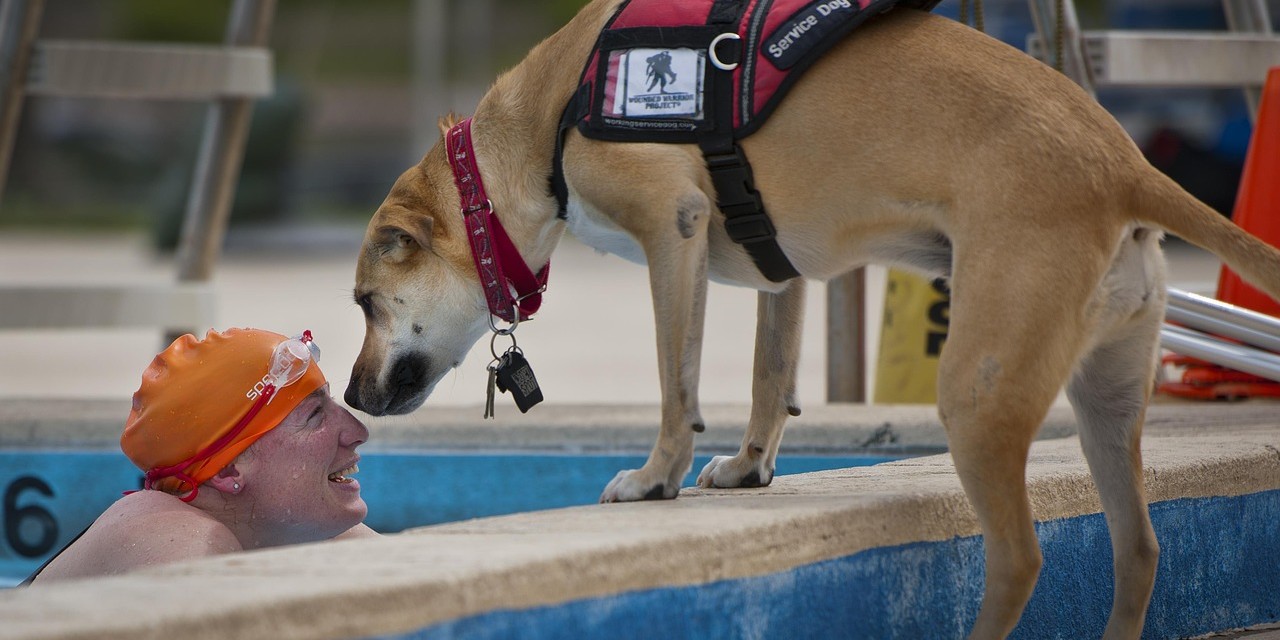Service Dog 2.0: the upgrade is here
by The Pawsitive Packleader, Inc.
Service Dog training in Seattle
Seattle is progressive. It is filled with creative individuals constantly pushing the boundaries of our knowledge and practices to find new paths. We have seen this in music, coffee, clothes, and even animals. We have some of the most progressive animal shelters in the country for both wild animals and companion animals. We have dog trainers generating new methods to utilize what science is discovering (see related articles: “Seattle gets a paw up in training” and “BAT girl: the superhero for reactive dogs around the world”). And now, thanks to Service Dog Academy, we have new breakthroughs happening in the training of service dogs.
For those of us who do not need assistance in daily living, the function of service dogs may not be very well understood. The first service dogs were seeing-eye dogs for the blind and often that is what people associate when they hear the words “service animal”. However, today service dogs are being trained to help with the most incredible tasks and new breakthroughs are happening right here in Seattle.
The Service Dog Academy in West Seattle is an incredible place. When I walked in for my interview with owner Mary McNeight I couldn’t help but feel a difference in the air. Lives are changed forever at the Service Dog Academy, almost in miracle fashion. Place yourself in the shoes of someone who is nearly completely immobilized. Mary will work with you and your dog to train them to put laundry in the washing machine, open doors that are not handicap accessible, bring you the phone if it rings in another room, take your shoes and socks off, turn on and off the lights when you leave or come home, or find help should you fall or become injured.
But the training a dog can receive is not the only thing that is special about Service Dog Academy. Typically if a person is in need of a service dog, they would contact a trainer and spend as much as $15,000 on a service dog that will be trained and ready for work in four months to two years. But at Service Dog Academy there are no mail-ordered surprises. Mary works with the owner to train their dog for service work. This means that while you will still be training with Mary for several months, your dog can begin to assist your lifestyle well before then. Plus for people who already have a dog, this is a much more convenient and less costly solution.
Mary McNeight’s business trains service dogs through positive methods. This is more humane and kind then the traditional pain-based methods that are usually used involving prong collars, choke chains and shock collars (see related article: “Are prong collars, choke chains, and shock collars humane?”).
Our program is unique in its approach to service dog training; we encourage dogs to be dogs. Our service dogs wag their tails when they are working and they really seem to enjoy their jobs. We aren’t turning out robots here. Service dogs are living beings and as such deserve the right to happiness both on and off duty.
Some of her most fascinating work is training dogs to assist diabetics. Dogs in the past have been trained to assist people with type-1 diabetes, but Mary is now training dogs to assist with type-2 diabetes. These dogs are trained to alert their owners to low blood sugars attacks, fetch sugary drinks to correct blood sugar imbalances, retrieve a blood glucose meter and insulin, and even to go find human help in an emergency. Due to their incredible sense of smell, dogs that are trained to alert for blood sugar changes generally notify their owner as much as 20 minutes before their blood glucose meter will register the high or low. This additional time can be critical in the life of a diabetic.
It’s fascinating, sometimes there’s an issue that the dog is much more accurate than the meter, and in these situations the dog is almost always right. This is crucial at a time when your meter is telling you to take insulin but really you are in the middle of a blood sugar crash.
Typically, if a person’s blood glucose level drops below 60mg/dl they will begin to feel incapable of functioning, while a level around 30 mg/dl can cause them to slip into a coma. These are some of the risks that a person with diabetes has to struggle with and fight on a daily basis. Mary read me an email from a client who said, “I don’t collapse in stores or on streets anymore because [my dog] catches my lows earlier then I do when I’m distracted.”
With the service dog that is able to detect the fluctuations in blood sugar, you never go into that dangerous low range or the really high range because the dog will sometimes alert you ten to twenty minutes before a meter can. Diabetic alert dogs make strict blood sugar control possible and help to prevent health risks from extreme highs and lows.
Mary was keen to point out that her training does not risk the health of the client. There are other trainers who train for diabetes alert that will ask clients to intentionally let their blood sugar get as low as 40mg/dl to train the dog to alert.
Some trainers that do this work require an EMT to be on stand-by since they require you to go to near comatose blood glucose levels.
Mary continues by talking about the functional problem that arises from this training:
If you train your dog to alert when you’re at 30[mg/dl] then that is when they are going to alert you. What you really want is your dog to say, “hey you just dropped below 80[mg/dl].”
The Service Dog Academy uses swab samples from glucose levels taken by the client based on when they want the dog to alert them. Some people feel low at 80mg/dl and others feel low at 60mg/dl. This makes the training customized to the client and because the dogs are learning with swab samples, they can be trained with their owners at normal, healthy glucose levels with no risk of inducing organ damage or a coma.
It never ceases to amaze me how incredible the things we are discovering dogs are capable of. Fifty years ago dogs were only being trained as Seeing Eye dogs for the blind. Today, Mary is training service dogs for a vast number of disorders. These include: epilepsy, diabetes, depression, PTSD, panic attacks, seizures, migraines, mobility assistance, hearing assistance, and narcolepsy. She is also experimenting to find new ways dogs can help people, such as those with Parkinson’s disease.
Service dogs are no longer just for the blind because as we are seeing there are so many incredible things a dog can detect. Any physical or bio-chemical change that happens in the body is a training opportunity for a service dog. Here at Service Dog Academy we are constantly looking to the future to find new ways to help improve people’s quality of life.















